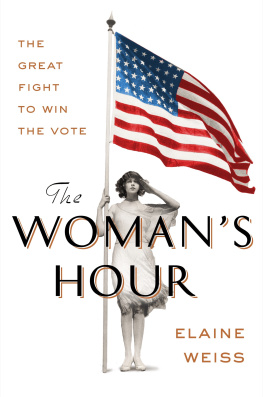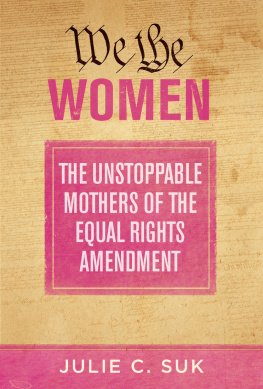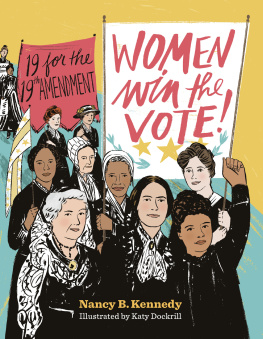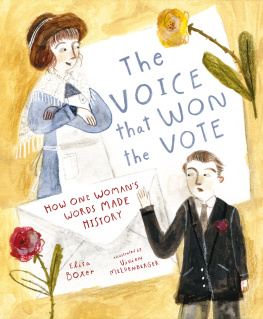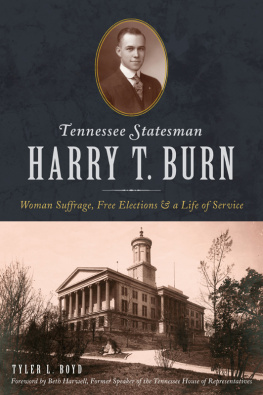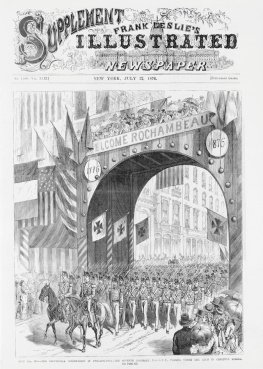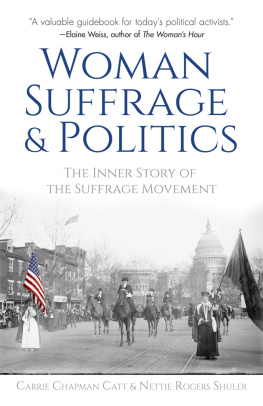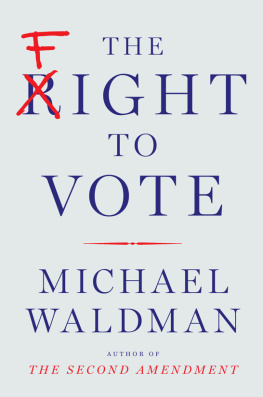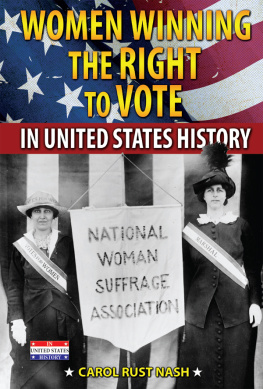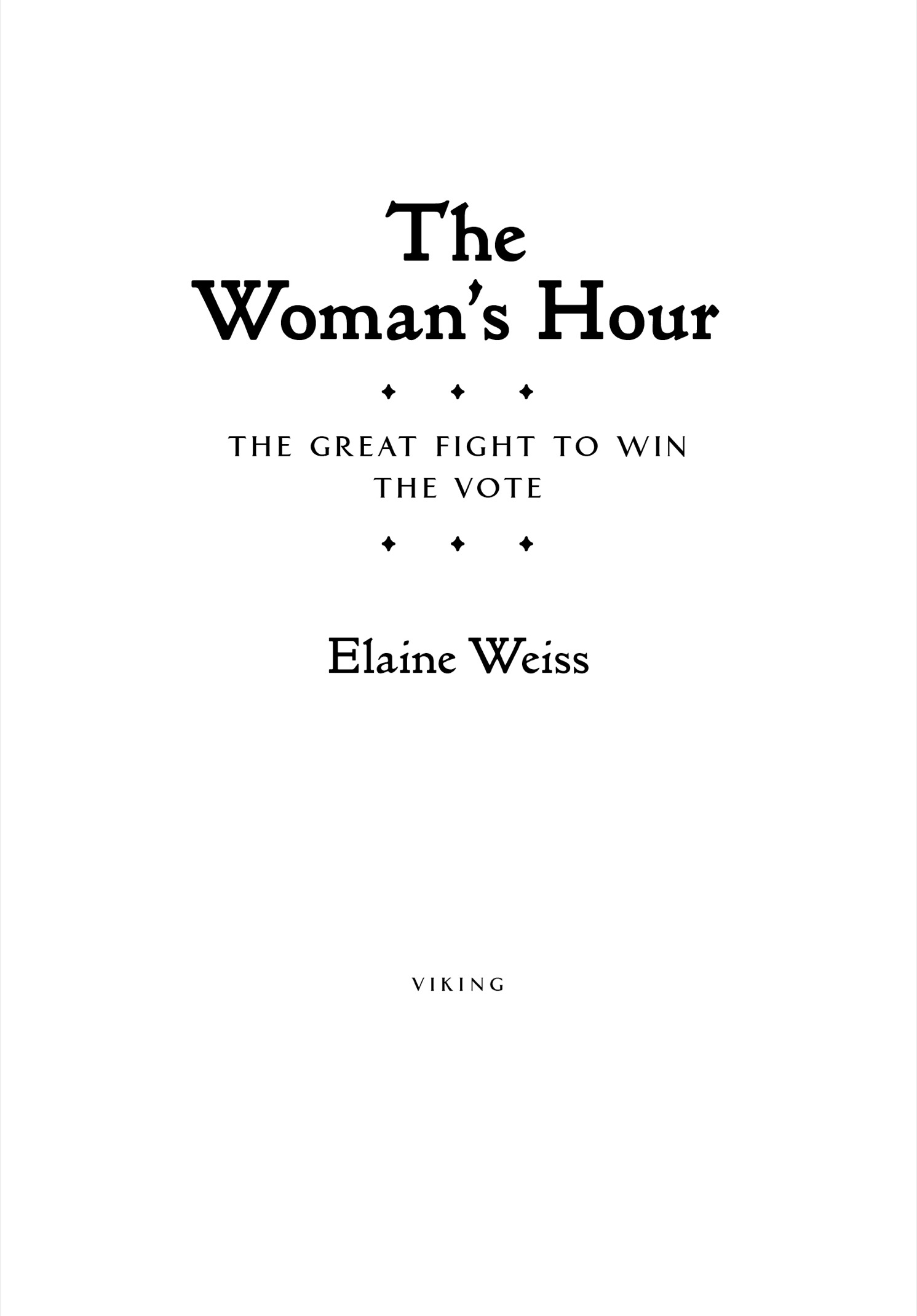Penguin supports copyright. Copyright fuels creativity, encourages diverse voices, promotes free speech, and creates a vibrant culture. Thank you for buying an authorized edition of this book and for complying with copyright laws by not reproducing, scanning, or distributing any part of it in any form without permission. You are supporting writers and allowing Penguin to continue to publish books for every reader.
In memory of my parents, who took their little girl into the voting booth, let her pull the magic curtain, and taught me to treasure my right to vote
The time has come to shout aloud in every city, village and hamlet, and in tones so clear and jubilant that they will reverberate from every mountain peak and echo from shore to shore: The Womans Hour has struck.
Carrie Chapman Catt, The Crisis, Presidential Address to the National American Woman Suffrage Association, September 1916
The right of citizens of the United States to vote shall not be denied or abridged by the United States or by any State on account of sex.
Nineteenth Amendment of the U.S. Constitution
Introduction
O N A S ATURDAY EVENING in mid-July 1920, three women raced toward Nashvilles Union Station on steam-powered trains. They each traveled alone, carrying a small suitcase, a handbag, a folder stuffed with documents. They were unremarkable in appearance, dressed in demure cotton dresses and summer hats; their fellow passengers could hardly imagine the dramatic purpose they shared: they had all been summoned to command forces in what would prove to be one of the pivotal political battles in American history.
This is the story of that battle, the furious campaign to secure the final state needed to ratify the Nineteenth Amendment to the U.S. Constitution, giving women the most fundamental right of democracythe vote.
Carrie Catt, the president of the National American Woman Suffrage Association, the preeminent suffrage organization in the nation, was on a southbound train from New York City. Josephine Pearson, president of the Tennessee State Association Opposed to Woman Suffrage, traveled north from her family home in the Cumberland Mountains of Tennessee. Sue White, a young activist for the National Womans Party, the militant wing of the suffrage movement, came fresh from a protest in the Midwest.
They converged on Nashville for the explosive climax of American womens seven-decade struggle for equal citizenship, and there was much at stake: thirty-six state approvals were required for ratification, and thirty-five were in hand. If the Tennessee legislature ratified the Nineteenth Amendment, woman suffrage would become the law of the land and twenty-seven million women would be able to vote, just in time for the fall presidential elections; if the legislature rejected it, the amendment might never be enacted. It all came down to Tennessee.
There were powerful forces opposing federal woman suffrage as it approached the legal finish line: political, corporate, and ideological adversaries intent upon stopping the Nineteenth Amendment. Some of the most vociferous foes of enfranchisement were the women Antis such as Josephine Pearson, who feared that womens entrance into the polling booth would hasten the nations moral collapse. The Suffs had reason to worry, as the amendment had already been rejected by nearly all the southern states, for the same blatantly racist reasons as put forth by Tennessee: if women got the vote, black women would also be entitled to the ballot. The presidential candidates were playing their own games, using woman suffrage as a pawn. This was the moment of reckoning, and both sides were willing to use every possible weapon to prevail.
Over the course of the next six weeks, the three campaign commanders were joined by more than a thousand women and men from around the state and across the countrySuffs, Antis, governors and senators, political operatives, corporate lobbyists, and beleaguered legislatorsall pouring into Nashville to enter the fray. The conflict quickly devolved into a vicious face-off, brimming with dirty tricks and cutting betrayals, sexist rancor, racial bigotry, booze, and the Bible, with the ghosts of the Civil War hovering over the proceedings and jitters lingering from the Great War amplifying the tension. The outcome remained in doubt until the very last moment.
The intensity of this battle in Nashville, the strength and nature of the suffrage oppositionled by women!the racial dimensions of the conflict, and the uncertainty of the outcome may seem surprising to us now, even shocking. Its too easy to imagine that the enfranchisement of American women simply arrived, like some evolutionary imperative, a natural step in the gradual march of progress. Or as a gift eventually bestowed by wise men on their grateful wives, daughters, and sisters. The women asked politely, staged a few picturesque marches, hoisted a few picket signs, and without much drama, Votes for Women was achieved. Thats not how it happened.
The very idea that women should have the right to participate in a government by and for the people was long considered radical, even dangerous, in the United States. Despite Abigail Adamss exhortation in 1776 to her husband, John, to remember the Ladies when forming the new American democracy, our esteemed Founding Fathers had absolutely no intention of giving women a voice in public affairs. Throughout the nineteenth and early twentieth centuries, women were condemned from the pulpit and in the press for thinking about suffrage; they were spit upon and pelted with rotten eggs for speaking out about it; and they were jailed for demanding it.
The struggle for woman suffrage was a long, bitter fight. It was waged on street corners and atop soapboxes, in city halls, Grange Halls, and the halls of Congress; it was fought in parlors and kitchens and bedrooms, under statehouse domes, at the bench of the U.S. Supreme Court, and finally in the Capitol building in Nashville and the elegant lobby of the nearby Hotel Hermitage.
Winning the vote required seventy-two years of ceaseless agitation by three generations of dedicated, fearless suffragists, who sought to overturn centuries of law and millennia of tradition concerning gender roles. The women who launched the movement were dead by the time it was completed; the women who secured its final success werent born when it began. It took more than nine hundred local, state, and national campaigns, involving tens of thousands of grassroots volunteers, financed by millions of dollars of mostly small (and a few large) donations by women across the country.
The movement developed great women orators, talented executives, and tenacious lobbyists. It nurtured feminist philosophers and astute politicians whothough they had no legal standing or governmental representationlearned to manipulate the levers of political power and pull the strings of public opinion. Women who had never had public lives were emboldened to speak out, to march in the streets, even to raise picket signs in public protest for the first time. Some were more strongly radicalized in their quest for civic equality and became willing to commit acts of civil disobedience and go to jail in pursuit of the franchise. Through the decades, the Cause changed the way women saw themselves and transformed societys view of women.

